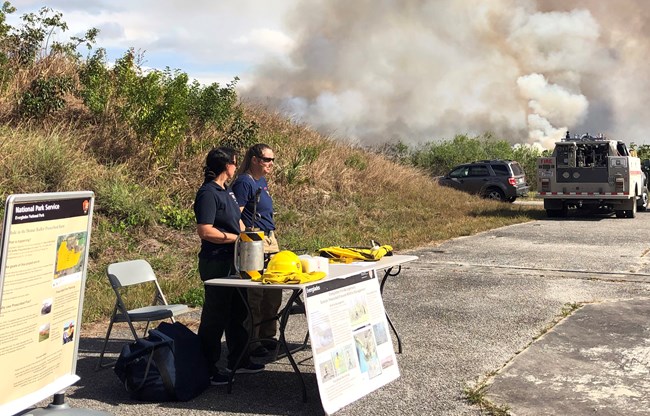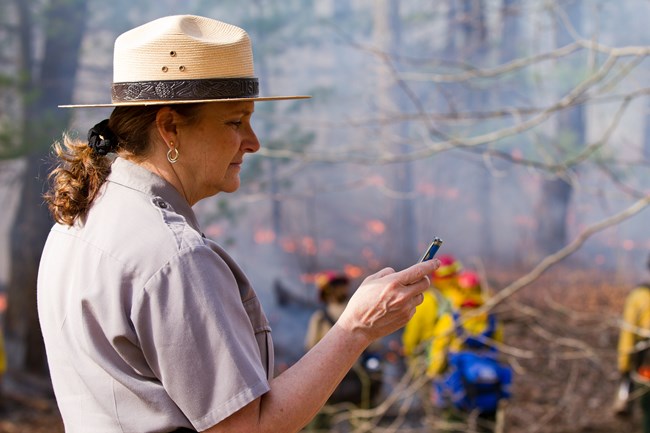Last updated: March 19, 2024
Article
Become a Public Information Officer
What does a Public Information Officer (PIO) do?
A PIO is responsible for the formulation and release of information about the incident to the news media, local communities, incident personnel, the incident management team, other agencies and organizations. As you progress in your training and development, you may become a lead public information officer, responsible for the management of other PIOs assigned to the incident.
NPS
The Incident Command System (ICS)
ICS is used to manage an emergency incident (like a wildland fire, search and rescue, hurricane, etc.) or a non-emergency event. The public information officer reports to the incident commander, who in turn reports to the agency or jurisdictions responsible for the incident. A good overview of ICS is provided in the independent study course titled Introduction to ICS (ICS-100).Who is eligible to be a PIO?
Technically, anyone can become a PIO, but it does require good interpersonal communication skills and writing skills to meet the needs of the position. There is training as well as taskbooks associated with three levels of public information officer positions. You can begin locally at the PIO Technician (PIOT) level by taking courses available online, there is no taskbook requirement for PIOT. Once completed, you can start training at the Type 3 level as a public information officer (PIO3). As you progress, the work can get more complex as reflected in the PIO Complex position (PIOC), which is the most advanced level.How do I start the process?
First, discuss your interest with your supervisor. Then, contact your local fire or emergency management officer who can initiate your taskbook. PIOs (who work fire and other events) are certified through the completion of requirements listed in the NIMS Wildland Fire Qualification System Guide. At first glance, the requirements may seem challenging, but the skills developed will serve you well on a daily basis. Training and qualifications are completed through four avenues:- Training Courses, which provide specific background knowledge;
- Position Taskbooks, which contain tasks, required to perform the job;
- Job Aids, to provide ready reference;
- Agency Certification, which provides the documentation certifying that the individual is qualified to perform in the specific job (this is the responsibility of the employing agency).

NPS/N. Lewis
Training
Some training is available online for free. Other courses are classroom only. See the NWCG Standards for Course Delivery for more details. Check with your fire management officer for information on upcoming training offered locally or periodically check the Wildland Fire Learning Portal for a schedule of classes nationwide. If you need assistance with funding for travel and/or tuition, consider the NPS Wildland Fire Workforce Development Grant Program (internal NPS link) and/or other NPS training grants and fellowships (internal NPS link).Information Officer Position Taskbooks
Your home unit must initiate the taskbook. Position taskbooks are available on the National Wildfire Coordinating Group positions catalog. Search for “Public Information Officer” to find the PIO taskbooks and qualifications.Physical Fitness Requirements
Typically, a PIO has no physical fitness requirements to hold that position, UNLESS that PIO will be expected to visit the fireline to take photos. A light duty work capacity test may be required.Fire Shelter Deployment
Another physical requirement includes demonstration that you can deploy, get in, and stay inside a fire shelter for a specified duration.
The Next Step
If you have taken the initial online training for PIOT, you will turn your certificates in to your training officer or supervisor to be reviewed to receive a qualification card for PIOT. There is no experience necessary to become a PIOT. You may then work toward certification as a PIO3, you will receive a qualifications card that states you are a PIO3(t) (public information officer trainee); as a PIO Complex trainee, your qualifications card would read PIOC(t).When any taskbook is completed, your home unit will finalize your certification. You should receive an Incident Qualifications and Certification System card (IQCS card or Red Card) from your park or regional fire management officer to state that you are qualified as a PIO – this will be required to go on the fireline on incidents. You must also be registered in the Interagency Resource Ordering Capability (IROC) system. Check with your local unit protocol on how to be added to IROC.
Remember once you have supervisor approval, let your local dispatch office know when you are available locally, regionally, or nationally. Regularly update your incident experience, training, and taskbook records with your fire program management assistant or dispatch with the IQCS update form.
You can work as a trainee as long as you have a red card, an initiated taskbook and an annual refresher. Training and taskbook must be completed to be fully qualified. Taskbooks expire three years from the date the first task in the taskbook is signed off. PIOs must have an assignment at least once every five years to maintain currency.
